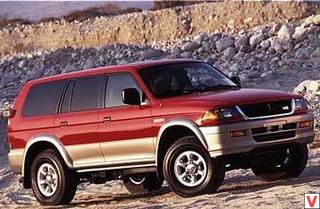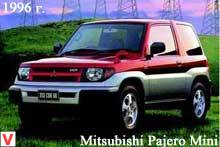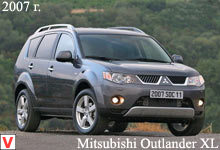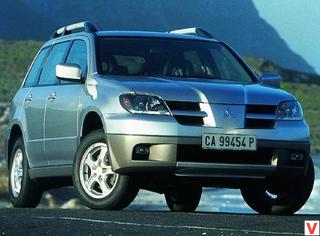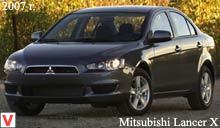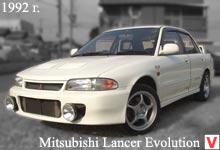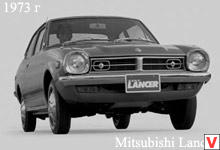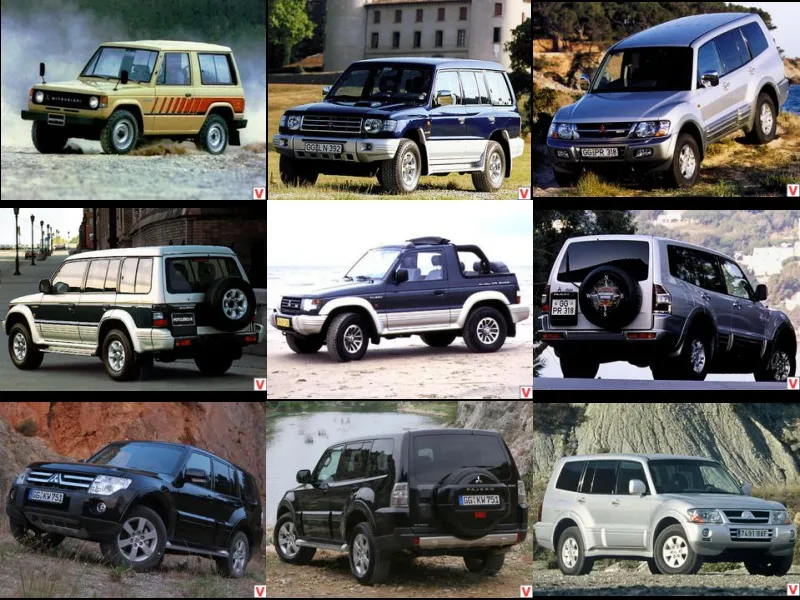
Mitsubishi Pajero - off-road vehicle. It was first introduced in Tokyo in 1981. The first generation in the ten years of its existence has not undergone any changes. The angular design of the body, the straight edges of the body panels, accentuated by the powerful bumper and solid bottom protection, underline the exceptional off-road qualities of the car, which are not affected by time. Along with the three-door all-metal closed body (4015x1680x1870 mm), the version with a soft folding top was also released, but it was not particularly popular due to its utility.
Later, the five-door station wagon and pick-up truck (4605x1680x1955 mm), which are very popular on the market, appeared very long in the market (2695 mm versus 2350 mm). Salon by modern standards is quite simple. Steering column with a variable angle. Body noise insulation is quite effective. The review back is satisfactory, only thanks to the huge exterior rear-view mirrors. Two independent air conditioners on the five-door version create the desired microclimate.
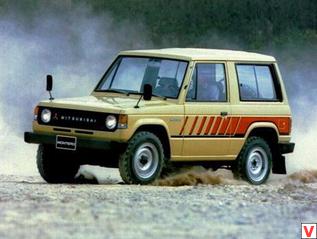
The trunk of the short-pajero, lined with carpet, is quite small. But if the rear seat is folded down and moved forward, then through the rear door open sideways, you can even put a two-chamber refrigerator or a large TV in the trunk. There is enough space in the cabin for comfortable landing of people up to 195 cm tall. Suspension front torsion independent, spring dependent dependent.
Since 1982, on all Mitsubishi Pajero mounted 84-power turbodiesel working volume of 2.3 liters, as well as a 2.6-liter gasoline power unit with a capacity of 103 hp In October of the same year, they were joined by a new 95-hp turbodiesel with the best torque characteristics. Since January 1987, only petrol versions have been equipped with catalytic converters, and with the launch of the 92-strong turbodiesel with an intercooler and 3-liter 111-strong V6 injection engines in September 1989, the sustainability of Pajero engines ceased to bother buyers in Europe. However, the voracity of the petrol version (up to 20 l / 100 km) remained a serious problem.
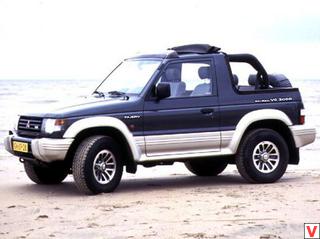
In some export markets, Pajero was sold under the names Montero and Shogun. The first generation was not in great demand. The unpretentious chopped forms and the overly simple design of all-wheel drive Pajero contributed little to the success of the model in the global market. For the failure of the progenitor of the next generation played, which appeared in January 1991 with a modernized body and a new transmission. The second generation was enthusiastically greeted all over the world.
The main constructive decisions remained the same: a powerful spar frame, an independent front suspension with wishbones and longitudinal torsions, the rear one remained dependent, but received springs instead of archaic springs. Sophisticated and successful design, excellent dynamics, good handling and excellent permeability allowed the Mitsubishi Pajero to boldly join the elite of expensive SUVs. Many attribute the popularity of the Pajero 1991 model year to an extraordinary appearance that is different from the conventional canons of off-road design. Others note the comfort and handling characteristics of the Mitsubishi. Others believe that success in advanced transmissions.
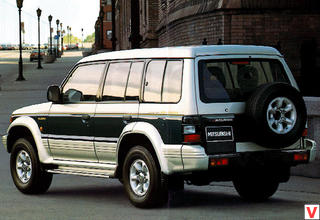
The car began to install a new all-wheel drive transmission Full Drive, which modes of operation (from the drive only to the rear axle with automatic shutdown of front axle gearboxes to all-wheel drive mode with locking center differential and downshifting) can be changed with a single lever on the go. As a result, the driver can easily choose (and control, thanks to the display on the instrument panel) the transmission mode that best suits the specific traffic situation. On request, Pajero can also be equipped with inter-wheel differential locking. Pajero produced with 3-and 5-door body, the latter had increased by 30 cm base and is usually referred to as the Wagon.
It was made in 5-seater and 7-seater versions. The three-door version was also produced with a fabric folding roof over the rear seat and a large hatch above the front one. Since 1994, equipped with new engines - diesel 1.8 TD and petrol 3.0-V6. Only in 1997, the company decided to resty, however, carefully preserving the main stylistic idea. In Europe, such cars began to be sold since 1998. Pajero got “bloated” barrel wings.
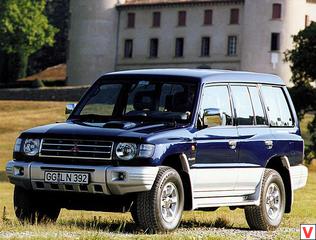
Options with narrow wheels and the same wings continued to admit under the name Pajero Classic. Since the fall of 1997, the 3.5 V6 GDI engine was installed on the Pajero. The trunk lined with carpet and short-base (3985x1695x1800 mm) Pajero, unfortunately, is still small even with the rear seat folded. This disadvantage, however, is not inherent in the spacious five-door station wagon with an increased roof height (4565x1695x1850 mm). The cabin can comfortably accommodate up to five passengers with a height of 189 cm. But there is also a 7-seater widened Semi High Roof Wagon model (4820x1775x1850 mm).
The form of the instrument panel is rounded, and now there are no corners on it (as on its predecessor). All devices are informative and well distinguishable, plus, well-thought-out lighting of the entire cabin and (even the pedals are lit). Grade altimeter, inclinometer and thermometer, showing the temperature overboard, is preserved. These useful (in the desert and mountains) devices are located on top of the console and covered with a separate canopy. All elements of adjustment of heating and ventilation are very convenient. Steering column adjustable.
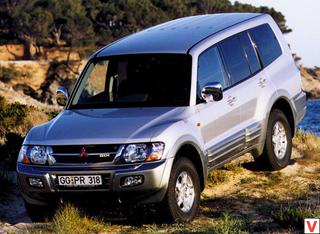
The seats are quite comfortable, and the backs are lumbar adjustment. All windows are electric, sunroof is also made with electric. Heated rear cabin is an independent heater, whose work can regulate the passengers themselves. The steering is quite informative.
Clarity of the clutch and gear lever just exemplary. The all-wheel drive system works flawlessly. Mitsubishi Pajero moves in a straight line steadily. ABS brakes are very effective and, despite the “soft” pedal, very accurate. Under the hood there can be a 150-horsepower 3.0-liter V6 (since April 1995) and a 3.5-liter 24-valve V6 with a capacity of 208 hp. (since April 1994), which in urban settings is one of the most economical among its kind.
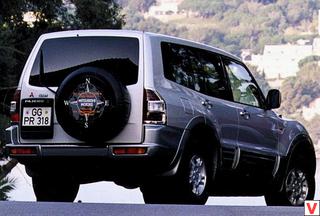
The 125-strong 2.8-liter turbodiesel (13.5 l / 100 km in the city) is worthy of praise for its efficiency. Injection 2.4-liter 111-horsepower engine may seem rather weak to some, and for the 3.0-liter 24-valve engine with 177 hp. (since 1997) the reputation is not very reliable. The dynamic Pajero data impresses with its flexible traction characteristic of turbo diesel and V-shaped injection "sixes", as well as with well-chosen transmission ratios. In the fall of 1999, the third generation of Pajero cars appeared (sales began in Europe in 2000).
During its previous 18 years of life, the model has gained a good reputation, thanks to its excellent road performance on any roads and excellent comfort. The third generation Pajero is significantly different from its predecessors. More rigid steel frame-carrying body, apply new spring front (on the transverse levers) and rear (on the longitudinal and transverse levers) independent suspension. The five-door version of the Pajero III generation compared to its predecessor has become 100 mm wider, 70 mm longer and 45 mm lower.
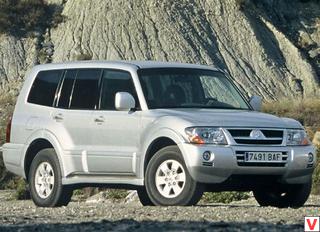
This version can comfortably accommodate seven people. The short 3-door version has a wheelbase of 2545 mm and a capacity of 5 people. The salon is equipped with a folding third row of seats. Pajero III engines, respectively, have different characteristics, there are even carburetor versions. In recent years, the third generation was equipped with the following petrol engines with injection: 2.4 liters (145 hp), 3.0 liters (177 hp), 3.5 liters (194, 208 and 280 hp .), as well as 3.5-liter (245 hp) with direct petrol injection. Diesel engines 2.5-liter (85 and 99 hp) and 2.8-liter (125 hp) had turbocharging.
This generation is equipped with a powerful 3.2 DI-D turbo diesel engine with direct fuel injection, a 3.5-V6 GDI petrol engine, a Super-Select SS4-II all-wheel drive transmission with a planetary center differential, an INVECS-II Sports Mode five-speed adaptive gearbox, independent front and rear spring hangers, as well as a monocoque body with a high-strength integrated frame. The Pajero has a memorable body design and a rather attractive interior. The car is comfortable and convenient, the driver's seat is designed ergonomically. Often among the devices are a compass, altimeter and body roll indicators.
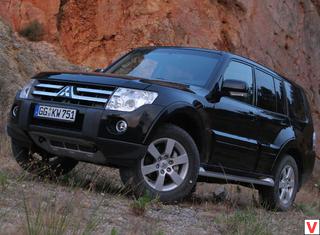
The level of equipment Mitsubishi Pajero III is traditionally high and, in addition to the mandatory four front front and side airbags, includes leather upholstery, automatic climate system, stereo equipment with a CD changer, etc. In 2004, the third generation re-styled Mitsubishi Pajero joined the fight for hearts and wallets of customers. In technical terms, the updated version is no different from its predecessor. The changes affected only its appearance and interior.
Thanks to the round fog lights and the new bumper shape, the upgraded Pajero turned out to be more toned and aristocratic. The changes also affected the radiator grille: its thin chrome trim with a chrome badge replaced its broad red chrome edging and red emblem. Wheels of the updated SUV - 6-, not 5-spoke, like the predecessor.
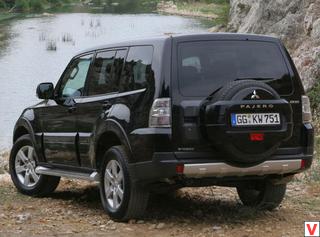
Harmoniously combined with the body and new steps with light, facilitating the landing / disembarkation in the dark. The side covers on the doors are now not ribbed, but smooth, and the turn signal repeaters are white (instead of orange). "Feed" cars got new lanterns and white turn signals mounted in the bumper. And the bumper itself was left without a wide chrome insert. Pajero has a balanced driving performance, excellent visibility, thanks to the high seating position of the driver and the advanced multi-mode transmission Super Select 4WD-II, which provides high throughput and directional stability.
The car is equipped with a 4-channel ABS integrated with electronic brake force distribution system EBD, which together provides high active safety. The body of Pajero, created by technology Mitsubishi RISE, will provide reliable protection for the driver and all passengers at impact. The front and rear zones of the programmed deformation dissipate the impact energy, and a very rigid supporting body with a powerful integrated frame and safety bars at the door form a force safety cage that protects people in the cabin in all situations. The safety system is supplemented with 3-point seat belts with pretensioners, front and side air bags for the driver and front passenger.
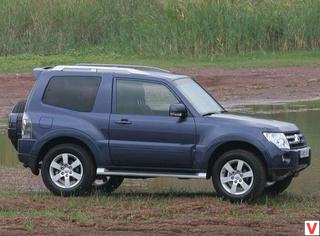
In 2006, the fourth-generation Pajero was presented to the public at the Paris Motor Show. Heirloom lines have not gone away: a characteristic step on the lower edge of the headlights (this was even at the very first Pajero), almost vertical roof racks, a window line in the rear, a door opening shape, a rear door opening to the right. The body actually remained the same.
The length, width and height have changed slightly - due to the new external panels. Only a quarter of the details went to the fourth generation as an inheritance, all the rest. Changes in the carrier structure of the body can be counted on the fingers: an additional transverse force element under the rear seat, a different bend of the amplifier under the front panel, an increased number of welding points at the junction of the engine shield and side members, shifted to the center and downward attachment of the spare wheel. Yes, another aluminum hood. The new body has become more rigid in torsion, as a result, improved handling on asphalt. The salon has been substantially redesigned.
The interior has become more modern and trendy. New dashboard. In the center of the new console appeared a large color display. In this case, the mutual arrangement of controls has not changed. Finishing materials are better. Soft plastic in a circle. Bagel - multifunctional.
The steering column is adjustable only on the angle of inclination. The seats of the first and second rows are comfortable. The driver's seat in the electric version is equipped with five adjustments, including the stiffness of the lumbar support. The rear visibility also improved significantly: the spare wheel was lowered by 50 mm.
The trunk with the third row seats folded is huge. Basic equipment for the Russian market includes: climate control, CD-receiver, alloy wheels, xenon headlights, rear air conditioning with manual control and cruise control. For the most expensive of the Russian versions (Ultimate), the prestigious Rockford Fosgate audio system, rear-view camera and navigation system are provided. The GDI V6 3.5 liter (202 hp) new gasoline V6 3.8 liter (250 hp.) With the proprietary electronic camshaft control system MIVEC and a variable intake manifold replaced the GDI engine. This engine is combined only with the adaptive five-speed automatic transmission INVECS-II Sports Mode.
Pajero accelerates to a hundred in 10.8 seconds. In the line of power units there is also a diesel version. The engine capacity of 3.2 liters got the Common Rail battery injection system of the new generation and develops 165 hp And for Russia, turbo diesel engines are supplied in a special adapted version for a cold climate and with exhaust that meets Euro 3 standards (Euro 4 for Europe and other countries). For the turbo diesel engine and a manual transmission, and a five-speed automatic. Front and rear suspension remained from the previous generation, but they were slightly reconfigured to add a smooth ride to the car.
Independent spring suspension: at the front with double wishbones, and behind the multi-link. The all-wheel drive system, controlled by electronics, will help the driver choose the most comfortable driving style. The company's SuperSelect transmission is now called Advanced (advanced) SuperSelect 4WD (SS4-II). It still offers four modes - rear-wheel drive, four-wheel drive, full with a locked center differential on an increased row and the same on a reduced one. In addition to the reinforced body, Pajero IV had inflatable “curtains” for head protection.
